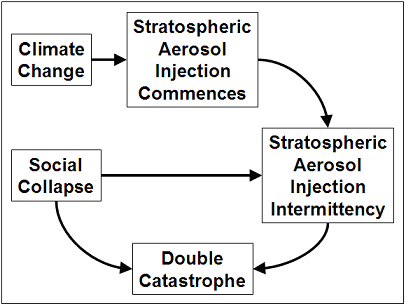GCRI has a new academic paper out. Double catastrophe: Intermittent stratospheric geoengineering induced by societal collapse, by Seth Baum, Timothy Maher, and Jacob Haqq-Misra, has been accepted for publication in Environment, Systems and Decisions.
The paper discusses a global catastrophe scenario involving climate change, geoengineering, and a separate catastrophe. In the scenario, stratospheric geoengineering is conducted to cool the warming temperatures associated with climate change. Then, an initial catastrophe separate from climate change prevents humanity from continuing the geoengineering, causing a rapid temperature increase. The initial catastrophe could be a war, disease outbreak, or something else. The rapid temperature increase would hit a population already weakened by the initial catastrophe. This ‘double catastrophe’ could have very severe effects, possibly including human extinction.
We had several motivations for writing this paper. First, we wanted to explore worst-case scenarios associated with climate change. We’re often asked ‘how bad could climate change get?’ This paper gives one answer. Second, we wanted to demonstrate the importance of systems thinking for global catastrophic risk analysis. Most GCR research considers one catastrophe at a time. The double catastrophe scenario involves two separate catastrophes interacting with each other to create even greater damages. A systems approach that includes multiple risks in one analysis is crucial for teasing out these important details. Here is a system diagram of the scenario:









Monday, 7 January, 2013
[…] 4, 2013 Global Catastrophic Risk Institute Double catastrophe: Intermittent stratospheric geoengineering induced by societal collapse | […]